On February 27, DRB-KAIST Sketch the Future Research Center was established in collaboration with the Dongil Rubber Belt (DRB) company, marking a new era of ultrafast productivity by combining three-dimensional sketching, generative AI, and virtual reality. The opening ceremony, held at the Department of Industrial Design Building (N25), was presided over by President Kwang Hyung Lee and DRB strategic advisor Seyeon Kim.

Failure to anticipate structural defects is the root cause of tedious development cycles in advanced manufacturing industries ranging from artificial proteins to robots. If researchers find errors in their design, they must discard their outputs and start from scratch. To expedite such processes, this research institute plans to utilize the latest virtual reality 3D sketching technology as a means of effective interaction between human intentions and construction programs. With just one sketch, artificial intelligence can gradually adjust a manual sketch to its virtual completion, removing the need for actual printing and product assessment.
The newly established research center will conduct cross-disciplinary robots, mobility, and protein construction research led by nine proponents specializing in these fields: Professor Seok-hyung Bae (Department of Industrial Design); Professor Hyun Myung (School of Electrical Engineering); Professor Dae-hyung Park and Professor Min-hyuk Sung (School of Computing); Professor Kyungsoo Kim, Professor Hae-won Park, and Professor Jemin Hwangbo (Department of Mechanical Engineering); Professor Ho-min Kim (Department of Biological Sciences) and Dr. Han-beom Park from KIST.
Through this partnership, DRB hopes to hold regular academic workshops and demonstration days to explore new products and new businesses of DRB-matching organizations for industry-academia exchange. They also aim to jointly attract large-scale national R&D support projects and create a new corporate operating system in preparation for the technological revolution of the mid-to-late 21st century.
Professor Bae, head of the research facility, explains the reason behind the center's creation, "The idea is that people can freely shape the potential of artificial intelligence according to their intentions". He adds, "If we would follow this line of thinking, I believe research whose proponents possess unrestrained creativity and natural thinking will become more and more valuable in the near future."

